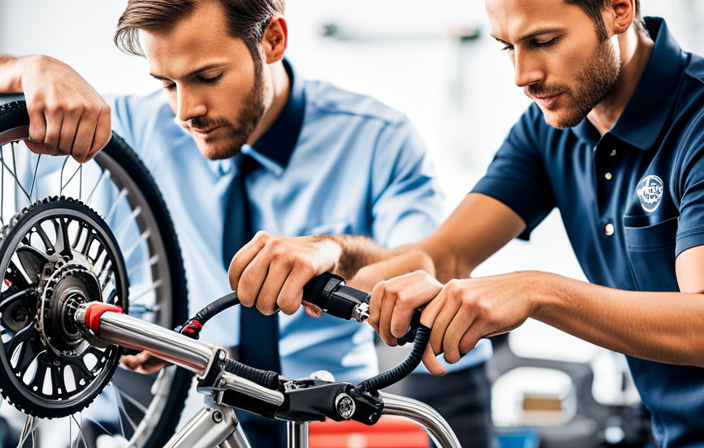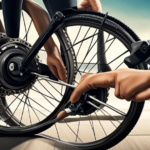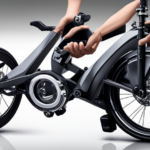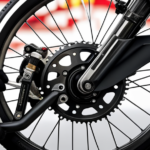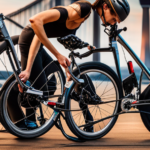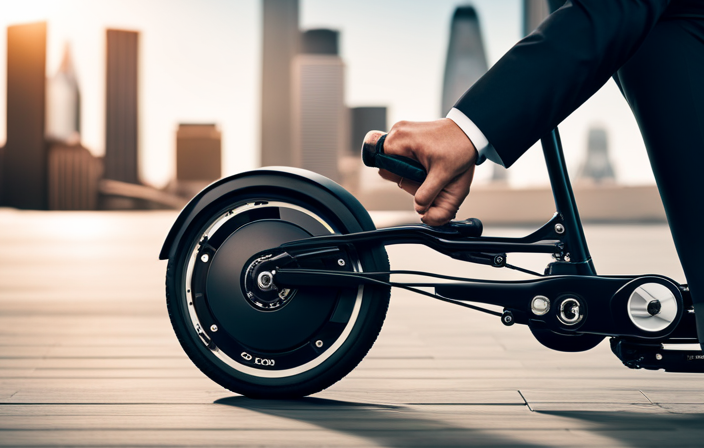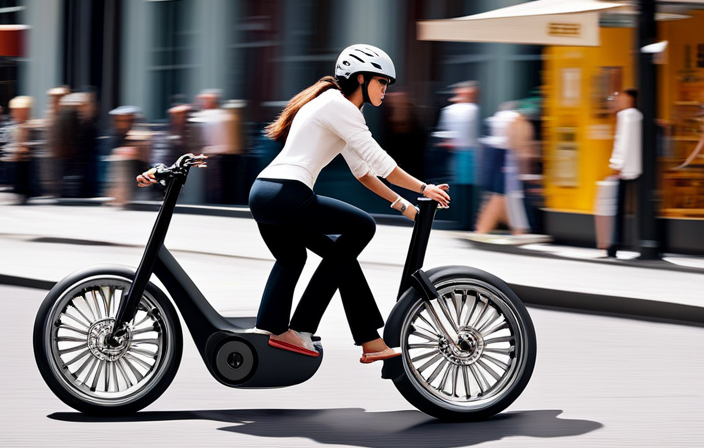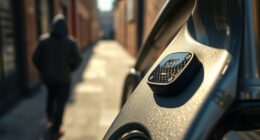Do you dream of cruising effortlessly on an electric bike, leaving behind the hassle of traditional transportation? Look no further!
In this step-by-step guide, we’ll show you how to install an electric bike conversion kit on your own bike. With our detailed instructions, you’ll be able to transform your regular bike into a powerful, eco-friendly, and efficient electric ride.
Get ready to embrace the future of transportation and enjoy the convenience and freedom it brings. Let’s dive in!
Key Takeaways
- Installing the wheel: Properly align the wheel between the brake pads and tighten the axle nuts. Adjust the brake pads evenly on both sides of the rim for proper alignment.
- Securing the battery and wiring: Mount the battery securely to the bike frame and connect the wiring harness to the battery, ensuring all connections are tight and secure.
- Testing and fine-tuning: Check the brakes and gears for functionality, examine brake pads for wear, and test the bike’s performance. Adjust brakes and gears as needed.
- Practicing riding and familiarizing with features: Understand power modes and pedal-assist level, practice smooth starting and stopping, familiarize with brake responsiveness, and pay attention to battery life and weight distribution.
Assess Your Bike’s Compatibility
First, you’ll want to check if your bike is compatible with the electric conversion kit. Begin by examining the frame of your bike. Ensure that it is sturdy enough to handle the additional weight and stress that comes with the electric components. Check if there is enough clearance between the frame and the wheels to accommodate the motor, battery, and other necessary parts.
Next, assess the drivetrain of your bike. Ensure that the chain, gears, and derailleur are in good condition and can handle the increased power provided by the electric motor. Additionally, check if your bike has a compatible bottom bracket size for the motor installation.
By thoroughly examining these aspects, you can determine if your bike is suitable for an electric conversion.
Now, let’s move on to choosing the right electric bike kit.
Choose the Right Electric Bike Kit
When deciding on the right kit for your e-bike, it’s important to consider factors like power, range, and compatibility.
The power of the kit determines how fast and how easily your bike can climb hills. You should choose a kit with sufficient power to meet your needs.
Range refers to how far your e-bike can travel on a single charge. Consider your typical riding distance and choose a kit that offers the range you require.
Compatibility is crucial to ensure that the kit fits properly on your bike and works seamlessly with your existing components. Take into account the specifications of your bike, such as wheel size and frame type, when selecting a kit.
Once you have chosen the right kit, it’s time to gather the necessary tools and equipment for the installation process.
Gather the Necessary Tools and Equipment
To gather the necessary tools and equipment for the installation process, you’ll need a set of wrenches and screwdrivers. These tools are essential for disassembling and reassembling various components of your bike. The wrenches will help you loosen and tighten bolts, while the screwdrivers will enable you to remove and secure screws. Additionally, you may require a torque wrench to ensure accurate and consistent tightening of bolts.
It is crucial to have the appropriate size and type of tools to prevent damage to your bike and ensure a successful installation. Once you have gathered the necessary tools, you can move on to preparing your bike for installation by following the next section’s instructions.
Prepare Your Bike for Installation
Before getting started, make sure you’ve thoroughly cleaned your bike to remove any dirt or debris that could interfere with the installation process. Cleaning the bike is essential to ensure a smooth and efficient installation of the electric bike conversion kit.
Here are three crucial steps to prepare your bike:
- Inspect your bike frame for any damages or cracks that may affect the installation process.
- Remove any accessories or components that may obstruct the installation, such as water bottle holders or bike bags.
- Check the tire pressure and ensure they are properly inflated for a safe and comfortable ride.
By following these steps, you will ensure that your bike is in optimal condition for the installation of the electric bike conversion kit.
Now, let’s move on to the next section and learn how to install the kit seamlessly.
Install the Electric Bike Conversion Kit
To successfully install the electric bike conversion kit, you’ll need to follow these steps:
-
Attach the motor to the wheel:
- Securely fasten the motor to the bike frame using the provided hardware.
- Follow the manufacturer’s instructions for proper installation.
-
Connect the controller and battery to the motor:
- Make sure all the necessary wires are properly connected.
- Ensure that the connections are secure.
Remember to refer to the manufacturer’s instructions throughout the installation process to ensure that everything is done correctly.
Attach the Motor to the Wheel
First, you’ll need to carefully align the motor with the wheel before attaching it. Begin by placing the motor on the axle, ensuring that it is centered and aligned with the wheel’s hub. Use the provided mounting brackets to secure the motor in place, making sure they are tightened securely.
Next, connect the motor’s power cables to the corresponding terminals on the wheel. Double-check that the connections are secure and that there are no loose wires.
Once the motor is properly attached, you can move on to the next step of the installation process. In the following section, we will discuss how to connect the controller and battery to complete the electric bike conversion.
Connect the Controller and Battery
Once you’ve attached the motor to the wheel, it’s time to connect the controller and battery. This step is crucial in ensuring the smooth operation of your electric bike.
To properly connect the controller and battery, follow these steps:
-
Connect the controller:
-
Locate the connection ports on the controller. They are usually labeled for easy identification.
-
Match the corresponding wires from the motor to the controller’s ports. Ensure a secure connection by firmly plugging them in.
-
Double-check the connections to make sure they are properly aligned and snug.
-
Connect the battery:
-
Identify the battery connection points on the controller. They are typically marked with positive (+) and negative (-) signs.
-
Attach the battery’s positive wire to the positive connection point and the negative wire to the negative connection point.
-
Confirm that the connections are tight and secure before moving on.
After connecting the controller and battery, you can proceed to adjust and secure the components for optimal performance without any interruptions.
Adjust and Secure the Components
To ensure the smooth operation of your electric bike, it is crucial to align the wheel and adjust the brakes accurately.
Begin by checking the alignment of the wheel, making sure it spins freely without any wobbling.
Then, adjust the brakes, ensuring that they engage smoothly and provide efficient stopping power.
Once the wheel and brakes are aligned, it is essential to securely mount the battery and wiring to avoid any potential hazards or malfunctions during your ride.
Pay close attention to the placement and fastening of these components, ensuring they are firmly in place and free from any loose connections.
Align the Wheel and Adjust the Brakes
To align the wheel properly, follow these steps:
- Loosen the axle nuts on both sides of the wheel using a wrench.
- Gently pull or push the wheel until it is centered between the brake pads.
- Once aligned, tighten the axle nuts to secure the wheel in place.
To adjust the brakes for optimal performance, follow these steps:
- Use a 5mm Allen wrench to loosen the brake caliper mounting bolts.
- Position the brake pads so they are evenly spaced on either side of the rim.
- Squeeze the brake lever to check for proper alignment and adjust as needed.
- Finally, tighten the brake caliper mounting bolts to secure the brakes in place.
With the wheel aligned and the brakes adjusted, you can now move on to securing the battery and wiring.
Secure the Battery and Wiring
Make sure to secure the battery and wiring by tightening the bolts and ensuring everything is properly connected. The battery is the heart of your electric bike, providing the power needed for a smooth ride.
Begin by locating the battery mount and aligning it with the designated spot on the bike frame. Insert the bolts and tighten them securely using a wrench.
Next, connect the wiring harness to the battery, making sure the positive and negative terminals are correctly matched. Double-check all connections to ensure they are snug and free from any loose wires.
Once the battery and wiring are secure, you can move on to the next step and test and fine-tune your electric bike for optimal performance.
Test and Fine-Tune the Electric Bike
Before taking the electric bike for a test ride, it is crucial to ensure its functionality and safety. Start by checking if the brakes and gears are working properly. Examine the brake pads for wear and tear and squeeze the brake levers to confirm their smooth engagement and release. Next, shift through each gear to verify the chain’s free movement and crisp shifts.
Now, it’s time to test the bike’s performance. Take it for a short ride, paying attention to any unusual noises or vibrations. Also, observe the bike’s handling and responsiveness. If everything feels good, move on to fine-tuning. Adjust the brakes and gears as necessary, following the manufacturer’s instructions.
Once you have completed these checks, you can proceed to practice riding and familiarize yourself with the electric bike’s features.
Practice Riding and Familiarize Yourself with the Electric Bike Features
Once you’ve gotten comfortable with the electric bike, take some time to practice riding and get familiar with its features.
Before you hit the road, make sure you understand how to switch between different power modes and adjust the pedal-assist level. Experiment with the throttle and practice starting and stopping smoothly.
Familiarize yourself with the brakes and understand their responsiveness. Take note of the battery life indicator and learn how to recharge it properly.
Pay attention to the bike’s weight distribution and how it handles turns and curves. Become acquainted with the gears and understand how they affect your speed and performance.
Maintain and Care for Your Electric Bike
To ensure optimal performance and longevity of your electric bike, it is crucial to regularly check and charge the battery. This will help you avoid unexpected power failures during your rides.
Additionally, keeping the motor and components clean and properly lubricated is essential in order to prevent dirt and debris from causing damage and reducing efficiency.
Regularly Check and Charge the Battery
Make sure you’re consistently monitoring and keeping the battery charged for your electric bike. The battery is the heart of your electric bike, providing the power needed to propel you forward. Neglecting the battery can lead to decreased performance and even complete failure.
To ensure your battery remains in optimal condition, follow these guidelines:
- Regularly check the battery level and charge it as needed.
- Store the battery in a cool, dry place when not in use.
- Avoid overcharging the battery, as it can shorten its lifespan.
By taking these steps, you’ll extend the life of your battery and maintain the performance of your electric bike.
Now let’s move on to the next section, where we’ll discuss how to keep the motor and components clean and lubricated.
Keep the Motor and Components Clean and Lubricated
Regularly cleaning and lubricating your motor and components ensures optimal performance and prevents unnecessary wear and tear.
To start, make sure your bike is turned off and disconnected from any power source.
Begin by wiping down the motor and components with a clean, dry cloth to remove any dirt or debris.
Next, inspect the motor and components for any signs of damage or loose connections. If you notice any issues, consult the manufacturer’s instructions or seek professional assistance.
Once everything is clean and free of damage, apply a small amount of lubricant to the moving parts of the motor and components, following the manufacturer’s recommendations. This will help reduce friction and ensure smooth operation.
Enjoy Your Electric Bike and Explore the Benefits of Eco-Friendly Transportation
Once you hop on your electric bike, you’ll quickly discover the many benefits of eco-friendly transportation. Here are some advantages of using an electric bike:
-
Environmentally friendly: Electric bikes produce zero emissions, helping to reduce air pollution and combat climate change.
-
Cost-effective: Compared to cars or motorcycles, electric bikes are much cheaper to operate and maintain. You’ll save money on fuel, parking fees, and insurance.
-
Health benefits: Riding an electric bike provides a great source of exercise, helping to improve cardiovascular health and strengthen muscles.
-
Convenient and efficient: Electric bikes allow you to bypass traffic jams and find parking easily. They also have a longer range compared to traditional bicycles, making them suitable for longer commutes.
Conclusion
Now that you’ve successfully installed your electric bike, it’s time to enjoy the benefits of eco-friendly transportation.
Take some time to familiarize yourself with the features of your electric bike and practice riding it.
Remember to maintain and care for your electric bike regularly to ensure its longevity.
With your new electric bike, you can explore the world around you with ease and contribute to a greener environment.
Happy riding!

